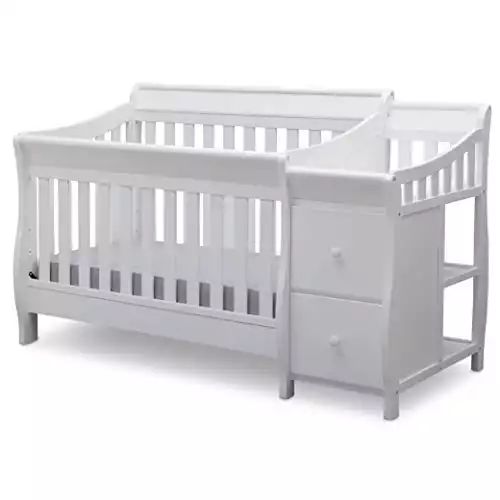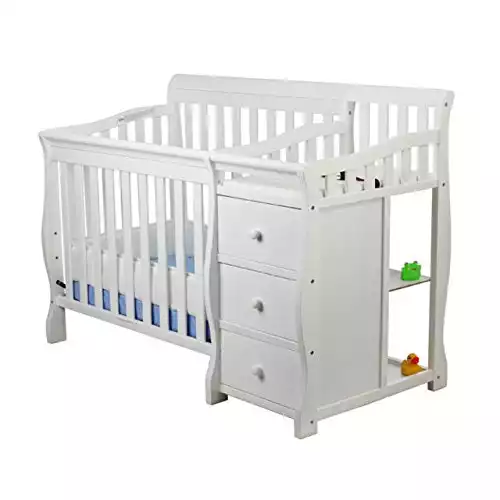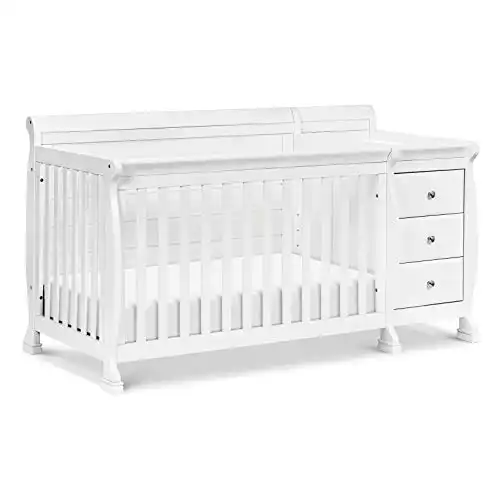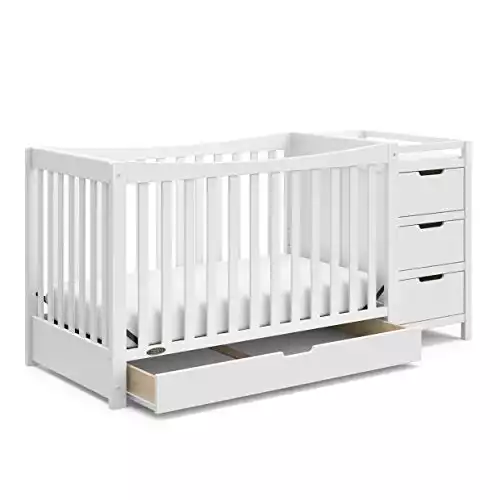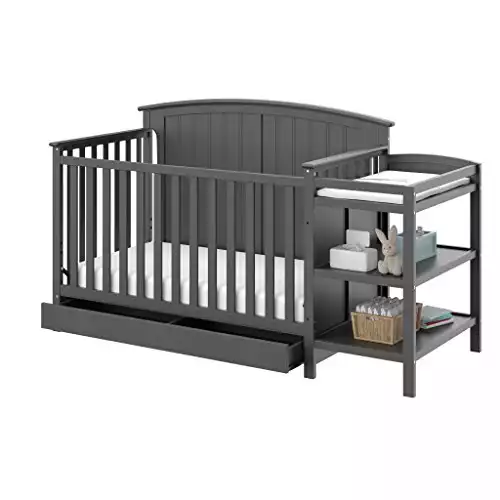Best Cribs With Changing Station
Are you trying to find the best crib with changing station?
Then let us help with our guide to the best convertible crib with changing table so you can find a baby crib changing table combo you’ll love!
When it comes to buying a crib there are a few additional features that can make your life easier, especially if you don’t have a room for several large pieces of baby furniture.
And one such feature is a changing table that attached to your crib.
Not only do they help to save on space, but having a crib attached to your changing table will also help reduce the amount of movement that you need to make when changing your sleepy baby, especially during night time feeds and diaper changes!
But with so many convertible cribs with changing table on the market, how do you know which one is the right fit for you?
Well, that’s why we put together this guide to the best baby crib and changing table combo so we can walk to through the features, pros, and cons of our favorite cribs with changing table.
And if you love this guide to the best crib with attached changing table, then make sure to check out these guides on best cribs for short moms, best mini cribs, and best crib alternatives.
This post contains affiliate links. See our full disclosure here
If you're looking for a crib and change table combo then the Delta Bentley S crib is an excellent option!
Not only is this Greengaurd gold certified crib made from sustainable New Zealand pine and painted in non-toxic paint, but it is also grows with your child.
The crib mattress can be adjusted to multiple heights, while the crib itself can be converted from a crib to a toddler bed to daybed and even a full-sized bed.
The changer itself features 2 shelves, 2 drawers, and includes a 27.75" x 16" x 1" changing pad (safety strap attached), so there is plenty of room for all your diaper essentials.
List of 5 Best Convertible Cribs with Changing Table
Best Crib with Changing Station
1. Delta Children Bentley S 4 in 1 Convertible Crib And Changer
There really is a lot to love when it comes to this Delta Bentley S crib and change table combo.
Firstly let’s look at the crib.
It is a 4 in 1 convertible crib which means you can configure it into 4 different settings to grow with your baby. A crib, a toddler bed, a day bed and a even a full-size style bed.
The crib also includes raised horizontal moldings on the panels, making it look less like a crib conversion when you convert it into a toddler bed, a daybed, or your full-size bed.
While the day bed rail is included, the toddler bed and full sized bed railings are sold separately.
There are also three different mattress heights to accommodate your baby.
Then there is the changing table that attaches to the side of the crib.
It comes with two large drawers and two open shelves for keeping all your diaper caddy essentials within close reach and organized.
It also features a 27.75″ x 16″ x 1″ changing pad with a safety strap attached.
Both the crib and change table station combo are made of sustainable New Zealand pine, painted with non-toxic paint, and Greengaurd gold certified.
The crib is also JPMA certified which means they meet or exceed all safety standards set by CPSC and ASTM.
t has a maximum weight limit of 35 pounds.
Assembled dimensions: 60.9L x 38.4W x 9.1H inches
Pros
- 2 large storage drawers and 2 shelves
- Convertible
- 4 adjustable mattress heights
- Greengaurd Gold Certified
- Sustainably sourced materials
- Non toxic paints
- Daybed rail included
Cons
- Only available in white and grey
- Toddler Guardrail & Full Size Bed Rails sold separately
- Mattress sold separately
If you're looking for a crib and change table combo then the Delta Bentley S crib is an excellent option!
Not only is this Greengaurd gold certified crib made from sustainable New Zealand pine and painted in non-toxic paint, but it is also grows with your child.
The crib mattress can be adjusted to multiple heights, while the crib itself can be converted from a crib to a toddler bed to daybed and even a full-sized bed.
The changer itself features 2 shelves, 2 drawers, and includes a 27.75" x 16" x 1" changing pad (safety strap attached), so there is plenty of room for all your diaper essentials.
2. Dream On Me Jayden 4-In-1 Mini Convertible Crib
If a full sized crib and change table is too large for your space then you may want to consider this Dream On Me Jayden 4-In-1 Mini Convertible Crib.
This Greengaurd gold certified, mini crib can be configured into 4 different configurations; crib, mini day bed, and twin-sized bed with or without a footboard. The bed rails are sold separately. The crib mattress is included.
The mini crib also features a heavy, detachable, 3 drawer changing table.
The changing table comes with a changing pad and a restraining strap with an easy-release buckle for your baby’s safety.
The Jayden crib is made of New Zealand native pine wood.
This crib is actually available in five types of finishes, enabling you to try and combine and match styles with any nursery themes.
The Jayden crib actually comes with a changing table, and a restraining strap with a special easy-release buckle. The three spacious drawers and 2 additional shelves are perfect for keeping baby essentials close by.
It is the perfect option for smaller spaces and areas without giving away style or functionality. When your baby grows out of the crib, you can convert it into a daybed, and it can be used as a twin bed with some optional rails.
All Dream On Me cribs are JPMS certified to meet/excel CPSC/ASTM standards, and their products are third-party lab tested for toxic elements so that they meet/excel ASTM and CPSC safety standards.
It has a maximum weight limit of 50 pounds.
Assembled dimensions: 56.75L x 29W x 41H inches
Pros
- Great for small spaces
- Convertible
- 5 color choices
- Greengaurd Gold Certified
- Sustainably sourced materials
- Non toxic paints
- Mattress included
Cons
- Bed Rails sold separately
- Does not convert to a toddler bed
- Only converts to twin sized bed
3. Da Vinci Kalani 4-In-1 Convertible Crib And Changer Combo
This product is a timeless nursery collection. It offers subtle charm to last long after the baby grows up.
The Kalani 4 in 1 Crib and Changer can be converted into 4 different configurations; crib, toddler bed, day bed, and a full-size bed with nightstand. The toddler conversion kit and full-size conversion kit are sold separately.
The mattress can be easily adjusted to 4 different heights as your baby begins to sit and stand.
The Kalani changing station sits on top of a compact 3 drawer unit with 2 spacious shelves to hold your baby clothes and diaper essentials. Built this detachable changing station with features like stronger drawer bottoms to make it sturdier and long-lasting
Kalani cribs feature a beautiful design and great functionality. They are built from 100% natural solid pine wood and are Greengaurd gold certified.
We love how durable the materials are for this brand of baby crib changing tables. A new mother shouldn’t have to worry about the sturdiness of her baby’s crib, so this brand has got you covered!
It has a maximum weight limit of 50 pounds.
Assembled dimensions: 71.75L x 34.25W x 39.75H inches
Pros
- Sturdy
- Convertible
- 5 color choices
- Greengaurd Gold Certified
- Sustainably sourced materials
- Non toxic paints
- Mattress included
Cons
- Conversion rail not included
- Mattress not included
- Only 3 color choices
4. Graco Remi 5-In-1 Convertible Crib And Changer With Drawer
Similar to other cribs featured the Graco Remi 5 in 1 is a Greengaurd gold certified, convertible crib. It can be configured as a crib, toddler bed, day bed, and a full-sized bed with or without a footrail.
But what we love the most about this crib is the underneath drawer which is ideal for storing all those baby blankets and less used items.
The changing station features 3 drawers with 2 open shelves. As well as a water-resistant changing pad with safety strap.
The crib and change table have been crafted with sustainable New Zealand pine wood, engineered wood, wood composites and includes Euro drawer glides.
It is also designed to match other Graco pieces.
Best of all this crib comes backed with a 1 year warranty.
It has a maximum weight limit of 50 pounds.
Assembles dimensions: 71.77L x 29.53W x 35.94H inches
Pros
- Full sized drawer under crib
- Convertible
- 4 color choices
- Greengaurd Gold Certified
- Sustainably sourced materials
- Non toxic paints
- 1 year warranty
Cons
- Mattress sold separately
- Bed Rails sold separately
5. Stork Craft Steveston 5-in-1 Convertible Crib And Changer With Drawer
The Stork Craft Stevenson is a stylish, Greengaurd gold certified, convertible crib. It can be configured 5 different ways; as a crib, toddler bed, day bed, and a full-sized bed with or without a footrail.
The crib mattress, toddler guardrail, and bed conversion kits are all sold seperately.
It comes with a super handy 2 compartment drawer underneath the crib which is ideal for storing all those baby blankets and less used items.
The changing station has a more minimalist feel to it than the other featured changing tables as it only features 2 open shelves and no storage drawers. This can make accessing your diaper changing products easier in a hurry as you’re not trying to open drawers, but it can also make it look untidy.
The changing table includes a water-resistant changing pad with safety strap.
The crib and change table have been crafted with sustainable New Zealand pine wood, engineered wood, wood composites and includes Euro drawer glides.
The crib is also JPMA certified which means they meet or exceed all safety standards set by CPSC and ASTM.
Best of all this crib comes backed with a 1 year warranty.
It has a maximum weight limit of 50 pounds.
Assembled dimensions: 72.3L x 28.9W x 42.1H inches
Pros
- Full sized drawer under crib
- Convertible
- 4 color choices
- Greengaurd Gold Certified
- Sustainably sourced materials
- Non toxic paints
Cons
- Mattress sold separately
- Bed Rails sold separately
Buyers Guide on Crib With Attached Changing Table
When buying a change table and crib combo there are some key things to consider before making your purchase as we will discuss below.
Safety
The top consideration should always be safety for any baby furniture. You want a strong mattress support and well-structured slats. You also want the mattress to have different height positions to avoid your baby tumbling out when they start to stand up.
While it’s not a requirement, many families like for their baby’s crib to have certification showing it’s free of harmful chemicals. So look for things like the GreenGuard certification to let you know if the crib has had third-party testing for VOCs and chemicals.
Versatility
Cribs are one of the more expensive pieces of baby furniture that you will purchase. So, you may want to consider how versatile the crib will be so you can get maximum usage from it.
If your crib can be converted, what configurations can it be converted into?
Some may find that a crib that converts into a toddler bed is more than adequate to meet their needs. Where as others may also want a crib that can be converted into a full-sized bed.
Either way you should consider sleeping options once your child outgrows their crib.
Also keep in mind that some of the convertible features like a toddler bed rail are sold separately, which could significantly increase your overall cost.
Strudy
Is the baby crib robust enough to support a changing table? This is what you need to ask yourself when buying your first baby crib with a changing table.
The changing table should be sturdy enough to support the weight of your baby and the products that are stored in the drawers overall.
Drawers
Not all changing tables will feature drawers, so you will need to decided if this is a feature that you would like or not.
Whilst drawers can be great at hiding away all your baby items, they can also be difficult to open when your in the midst of dealing with a diaper blowout.
Color & Design
Although it’s a personal preference, you want a crib that looks nice and matches the décor of your baby’s nursery or your bedroom. Most of the options on this list come in several wood colors, so it’s possible to find something that works for your theme.
If you're looking for a crib and change table combo then the Delta Bentley S crib is an excellent option!
Not only is this Greengaurd gold certified crib made from sustainable New Zealand pine and painted in non-toxic paint, but it is also grows with your child.
The crib mattress can be adjusted to multiple heights, while the crib itself can be converted from a crib to a toddler bed to daybed and even a full-sized bed.
The changer itself features 2 shelves, 2 drawers, and includes a 27.75" x 16" x 1" changing pad (safety strap attached), so there is plenty of room for all your diaper essentials.
FAQs on Best Baby Crib and Changing Table Combo
While not essential, baby cribs with a changing table can be extremely useful. Not only do they help to save on space, but having a crib attached to your changing table will also help reduce the amount of movement that you need to make when changing your sleepy baby, especially during night time feeds and diaper changes!
Whether or not the changing table comes off the crib will depend on the brand of the crib and changing table combo. Some convertible cribs and changing tables on our list, such as DaVinci Charlie 4 in 1 Convertible Mini Crib, have the option to convert the crib into a bed and the changing table into a detached nightstand for extended use.
Yes! We think changing tables are definitely worth it! A dedicated changing table provides you with all of your needs at your fingertips. They give you space for extra diapers, wipes, diaper creams, and for extra onesies in the case of a diaper blowout. Many also come with drawers to neatly store away all your diaper essentials.
A crib with a changing table attached can be a great choice for parents who have limited space. They are also a fantastic choice to help reduce the amount of movement that you need to make when changing your sleepy baby, especially during nighttime feeds and diaper changes.
Final Thoughts on Best Crib with Changing Table Station
Cribs with a changing table are not only make a practical and functional edition to a nursery, but they are also great for small spaces.
All the options in this guide are great convertible cribs with change tables, so which one you choose will come down to your personal preferences.
We hope this guide has been helpful in making your decision!
And if you want to check out any more of our guides, we recommend checking out these guides on best waterproof crib mattress pad, mini crib vs crib, and how many crib sheets do I need.


